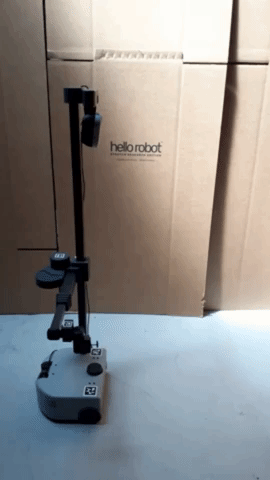Teleoperate Stretch with a Node
Example 1

The goal of this example is to give you an enhanced understanding of how to control the mobile base by sending Twist messages to a Stretch robot.
Begin by running the following command in a new terminal.
roslaunch stretch_core stretch_driver.launch
Switch to navigation mode using a rosservice call. Then, in a new terminal, drive the robot forward with the move.py node.
rosservice call /switch_to_navigation_mode
cd catkin_ws/src/stretch_tutorials/src/
python3 move.py
To stop the node from sending twist messages, type Ctrl + c.
The Code
Below is the code which will send Twist messages to drive the robot forward.
#!/usr/bin/env python3
import rospy
from geometry_msgs.msg import Twist
class Move:
"""
A class that sends Twist messages to move the Stretch robot forward.
"""
def __init__(self):
"""
Function that initializes the subscriber.
:param self: The self reference.
"""
self.pub = rospy.Publisher('/stretch/cmd_vel', Twist, queue_size=1) #/stretch_diff_drive_controller/cmd_vel for gazebo
def move_forward(self):
"""
Function that publishes Twist messages
:param self: The self reference.
:publishes command: Twist message.
"""
command = Twist()
command.linear.x = 0.1
command.linear.y = 0.0
command.linear.z = 0.0
command.angular.x = 0.0
command.angular.y = 0.0
command.angular.z = 0.0
self.pub.publish(command)
if __name__ == '__main__':
rospy.init_node('move')
base_motion = Move()
rate = rospy.Rate(10)
while not rospy.is_shutdown():
base_motion.move_forward()
rate.sleep()
The Code Explained
Now let's break the code down.
#!/usr/bin/env python3
Every Python ROS Node will have this declaration at the top. The first line makes sure your script is executed as a Python3 script.
import rospy
from geometry_msgs.msg import Twist
You need to import rospy if you are writing a ROS Node. The geometry_msgs.msg import is so that we can send velocity commands to the robot.
class Move:
def __init__(self):
self.pub = rospy.Publisher('/stretch/cmd_vel', Twist, queue_size=1)#/stretch_diff_drive_controller/cmd_vel for gazebo
This section of code defines the talker's interface to the rest of ROS. pub = rospy.Publisher("/stretch/cmd_vel", Twist, queue_size=1) declares that your node is publishing to the /stretch/cmd_vel topic using the message type Twist. The queue_size argument limits the amount of queued messages if any subscriber is not receiving them fast enough.
command = Twist()
Make a Twist message. We're going to set all of the elements since we can't depend on them defaulting to safe values.
command.linear.x = 0.1
command.linear.y = 0.0
command.linear.z = 0.0
A Twist data structure has three linear velocities (in meters per second), along each of the axes. For Stretch, it will only pay attention to the x velocity, since it can't directly move in the y or the z direction.
command.angular.x = 0.0
command.angular.y = 0.0
command.angular.z = 0.0
A Twist message also has three rotational velocities (in radians per second). Stretch will only respond to rotations around the z (vertical) axis.
self.pub.publish(command)
Publish the Twist commands in the previously defined topic name /stretch/cmd_vel.
rospy.init_node('move')
base_motion = Move()
rate = rospy.Rate(10)
The next line, rospy.init_node(NAME, ...), is very important as it tells rospy the name of your node. Until rospy has this information, it cannot start communicating with the ROS Master.
Note
the name must be a base name, i.e. it cannot contain any slashes "/".
The rospy.Rate() function creates a Rate object. With the help of its method sleep(), it offers a convenient way for looping at the desired rate. With its argument of 10, we should expect to go through the loop 10 times per second (as long as our processing time does not exceed 1/10th of a second!).
while not rospy.is_shutdown():
base_motion.move_forward()
rate.sleep()
This loop is a fairly standard rospy construct: checking the rospy.is_shutdown() flag and then doing work. You have to check is_shutdown() to check if your program should exit (e.g. if there is a Ctrl-C event or otherwise). The loop calls rate.sleep(), which sleeps just long enough to maintain the desired rate through the loop.
Move Stretch in Simulation

Using your preferred text editor, modify the topic name of the published Twist messages. Please review the edit in the move.py script below.
self.pub = rospy.Publisher('/stretch_diff_drive_controller/cmd_vel', Twist, queue_size=1)
After saving the edited node, bring up Stretch in the empty world simulation. To drive the robot with the node, type the following in a new terminal
cd catkin_ws/src/stretch_tutorials/src/
python3 move.py
To stop the node from sending twist messages, type Ctrl + c.